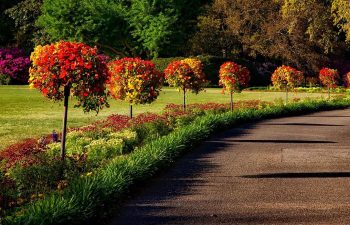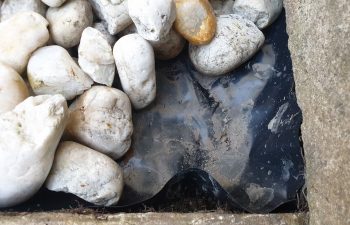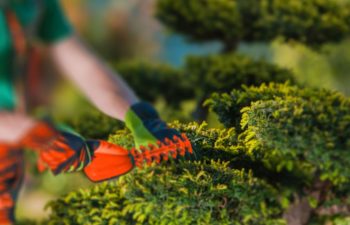Having a gorgeous lawn is something that any homeowner would want to have. They will have pride in their home and would want to share it with everyone.
The impression that you get when drive by your home matters a lot.
However, if you have tried to have a great looking lawn in vain, it doesn’t mean that you have to give up.
We are going to guide you on some new lawn care tips to implement to ensure that you have a beautiful and lush lawn.
What products do you need to keep a new lawn in top condition?
- Lawn mowers
- Rakes and blowers
- Sprinklers and spreaders
- Edgers and Trimmers
Your newly installed SOD needs to be well taken care of to maintain its aesthetic look year-round. Maintain your lawn health by proper watering, taking care of weeds, and controlling the pests as well as diseases.
Here are some of the products that you can use to ensure that your new lawn establishes quickly.
Lawn mowers
To keep your grass at a manageable height, you need to have a lawn mower. Today many models on the market come in different sizes and style. The best choice will depend on the size of your lawn, budget, and the terrain.
If your lawn is not large, a push mower is the most appropriate. However, if have a large lawn with significant elevation variation go for a riding mower.
Rakes and blowers
To keep your lawn nice and clean, you need a rake and a blower. These tools will assist you in removing debris and leaves. A rake will assist you in gathering grass clippings, especially after mowing. It also helps in collecting fallen leaves on a small lawn.
However, if your lawn is big, you can opt for something faster like the blower.
Sprinklers and spreaders
The sprinklers assist in maintaining hydration in hot weathers especially if you do not receive much rainfall. Sprinklers are also very vital in the first month after you have installed the SOD to provide enough water for the grass to establish.
Another important tool to consider is a spreader; this tool is useful in the even distribution of fertilizers and herbicide on the lawn.
Edgers and Trimmers
Edgers will help you to manicure your lawn and separate the grass from other plants. Trimmers are also useful tools to ensure that the grass remains at the desired level especially at the edge of your house.
Additionally, the trimmers will help you to cut the grass in areas the mower cannot reach.
Best fertilizer for your new lawn
After the sod has taken root (not less than 30 days), use a complete fertilizer that contains Nitrogen, Phosphorous, and Potassium. Ensure you follow the application on the fertilizer bag to avoid burning your lawn with too much fertilizer.
Most lawn care companies suggest heavier application of the fertilizer before winter to promote vigorous root development in winter as well as quicker green up in the spring.
General New Lawn maintenance guide
You need to take care of your new lawn like a newly born baby. Invest your time, energy and money to take care of it, and it will reward you with an attractive front yard, which you can hold home parties, and be proud of it.
You need to feed your new lawn, water it, caress it if you have to, but most of it don’t give up if you do not get the desired results.
Tips for maintaining a perfect lawn
After the lawn is laid out and the contractor has left, we will guide you on how to take care of your new lawn and transform your worn out yard into a lovely lawn to compliment your home. Taking care of your lawn at the first stages is very important to make it establish faster and flourish. After laying the new sod, follow this maintenance practices to ensure the survival of the lawn.
Watering
Proper watering is crucial to ensure that even root development of the sod. To make sure that your lawn is well watered you can put in place an irrigation system or have an overlapping pattern of sprinklers set up throughout the lawn to ensure that every part is covered.
For the first 14 days, water your lawn lightly for 20-30 minutes twice daily. After the grass has established roots and becomes firm on the ground, increase the time of watering but decrease the frequency of watering and does it twice or thrice a week.
This will harden the grass and give it time it needs to breath. Additionally, watering the sod regularly may lead to over watering which causes many issues such as root rot, mold development and stunted growth.
After the fourth week and the grass have already established the roots, you can decrease the watering frequency further to 1-2 times per week. This should continue for the rest of the year but always ensure that your lawn gets at least one inch of water each week.
The best way to make sure that you are not over watering the lawn is to place a container on path of a sprinkler and time how long it will take to collect one inch of water. Remember, the time period will differ according to weather period.
For this reason, ensure that you adjust the watering accordingly.
What is the best time to water?
The best time to water is early in the morning before 5 am, and late in the evening after 9 pm. This time is usually less windy cooler and there is more humid which means that the evaporation rate is minimal.
This means more efficiency in the use of your water. Additionally, the water pressure tends to better at this time allowing you to cover all the areas efficiently.
Other watering tips
No one likes would like the idea of being out on a late night hour watering the lawn because of the chilly weather. However, watering water in one cycle or in a very short period is dangerous.
If you increase the water pressure and water too quickly, it will often run off tuff areas because of the slopes, heavy clay soils, thatch and compaction. To avoid this you can apply the water into two back-to-back irrigation.
This will allow the soil to soak the water instead of having a lot of runoff. Some of the other practices that can reduce the runoff include aeration, reducing compaction as well as thatch.
Feeding the lawn
Feeding your lawn is very important for development of healthy and lush lawn. The first fertilizer is done when installing the sod so you do not need to fertilize in the first one month.
Fertilizing before 30 days are over often causes yellow patches since the shallow roots cannot absorb the nutrients and the nitrogen will leach into the soil. You should apply a granular fertile with phosphorus, Nitrogen and potassium after a minimum of 30 days.
The fertilizer will give the grass it needs for healthy growth making it resistant to common diseases and fungal problems. The fertilizer application should be done when the ground is dry and ensure that you spread it over the lawn.
After the application, water the lawn thoroughly. Recommended fertilizer application times are 3-4 times annually with the best period being the beginning of June and the months of October and September.
Mowing
The first mowing should be done after the grass has rooted into the soil surface so that it can’t be pulled up from the ground. Typically, you should mow your new lawn after 10-14 days after installation.
When the leaves reach the height of 3 inches, mow your lawn removing only a third inch of the leaf blade. Cutting the grass shorter than 2.5 inches will lead to less root penetration, weakening the lawn.
Remember, the root system accommodates the height of the leaf blade. This means that the higher you cut the deeper the roots will develop for a more luxuriant lawn.
Additionally, ensure that the blades of your mower are always sharp. Cutting the lawn will dull blades will tear the leaf blades making the grass to lose moisture more rapidly.
This damage also makes the lawn more susceptible to diseases and insect attacks.
Aeration
To allow the grass to grow to full potential, the roots need air to enhance healthy growth. Well-structured soil has a lot of air pockets throughout the soil profile giving the roots of the plant’s plenty of air.
However, over time, the soil becomes compacted and squashing all the air pockets.
Compaction of soil also leads to a number of problems such as the lawn being water logged since the water cannot drain. The roots of the grass cannot access the nutrients leading to weaker growth.
The aeration process will get air back to the soil, easing the compaction. This will allow water, air, and fertilizer to penetrate to the root zone of the grass for healthy growth.
Lawn Weeds and disease control
Controlling the weeds and diseases ensures that you have a healthy lawn. Controlling the weeds is rather easy, as you just need to maintain a proper watering schedule and fertilizing program.
If you do this, the turf will be thick enough and there will be no room for weeds to start. However, if the weeds become a problem hand weeding or herbicide use is recommended.
You can control the annual weeds such as mallow and crabgrass with a pre-emergent herbicide application in early April.
Control the broad-leaf weeds such as plantains, clovers and dandelions by applying an herbicide in September or May.
Diseases rarely attack your new sod although there is a great threat of fungal disease if you do not water properly.
Ensure you follow the correct watering techniques and avoid over fertilizing.
Other maintenance tips
Avoid walking on the lawn
For the first 10 days after establishing your new lawn, you should avoid walking on the sod.
You should also keep traffic to a minimum for 3-4 weeks after sod installation especially if the conditions are overly wet or dry. Remember, your sod is establishes roots during the first month and disturbance can lead to stunted growth.
If you must walk on the sod, use a different route every time to avoid treading on the same area. You should also take measures to prevent other individuals from walking on the lawn.
You can do this by marking a perimeter with string, tape or stakes.
Get rid of the destructive insects
The insect problem is likely to increase during the hot dry summers.
Ensure that you keep a keen eye on the insect and purchase the appropriate pesticides to control them.
Monitor your lawn for signs of stress
Monitor the signs of stress on your lawn by checking any signs of dehydration or yellow patches. Dehydration means that your lawn is not getting enough water.
You can notice dehydration by yellowing or drying out of the root matter. If you find these signs, increase the water frequency.
A few last words
It is a great feeling to have a lawn that you can be proud of. It will not only improve the look of your home but it can also add value to your property.
With the right sod, relevant maintenance tips and products to use for your new lawn, you can have a lawn that is the envy of the neighborhood.













